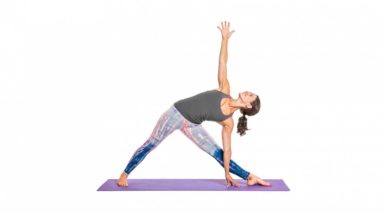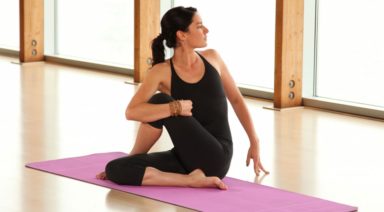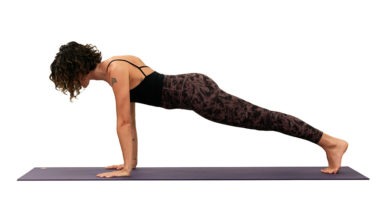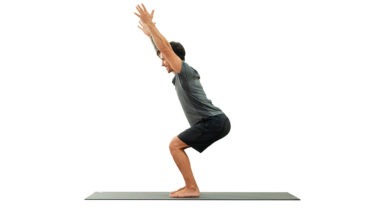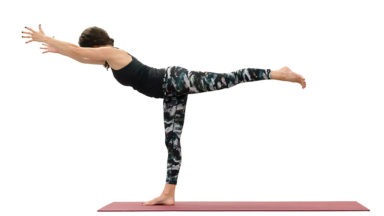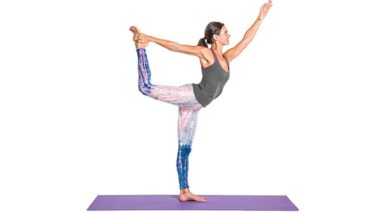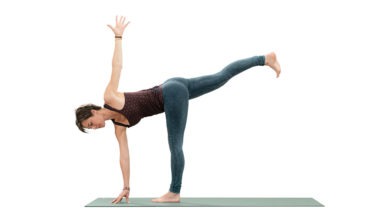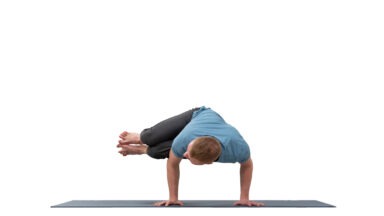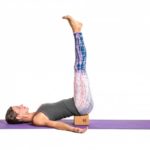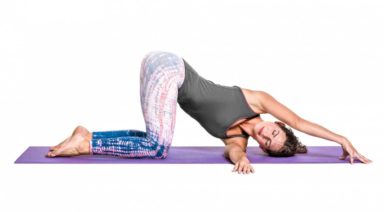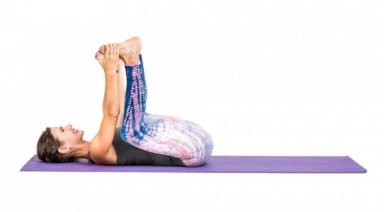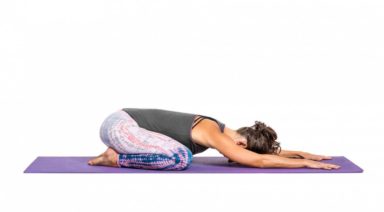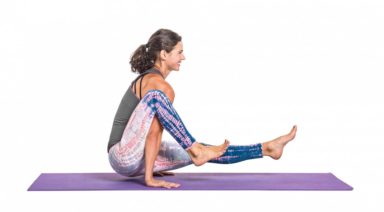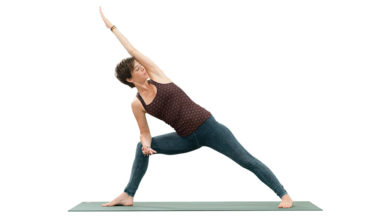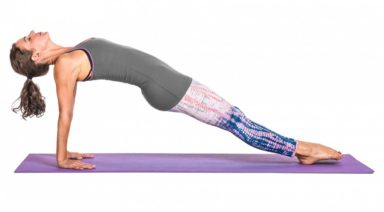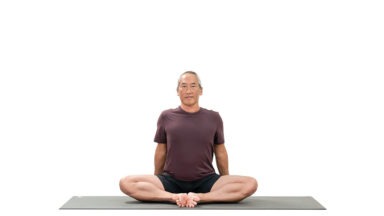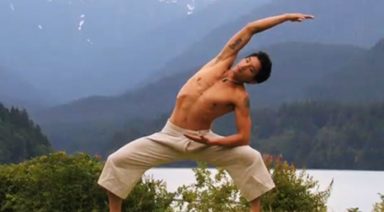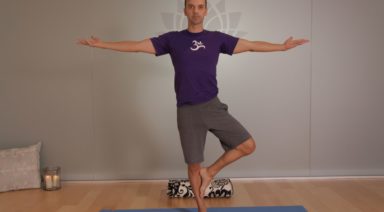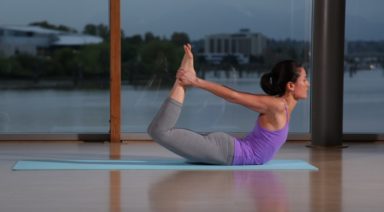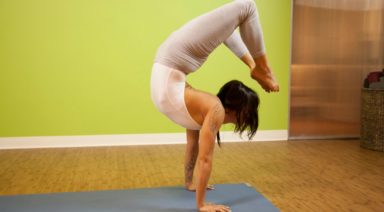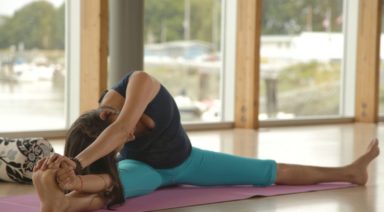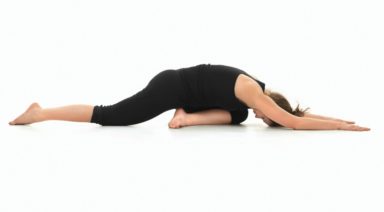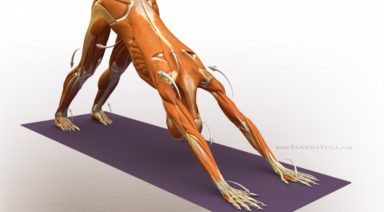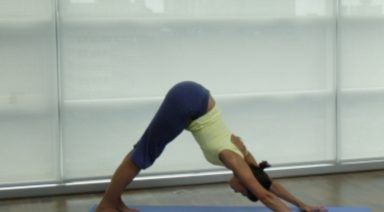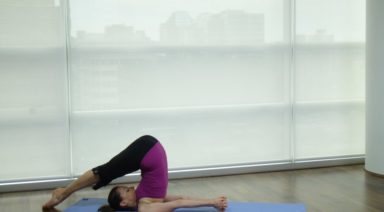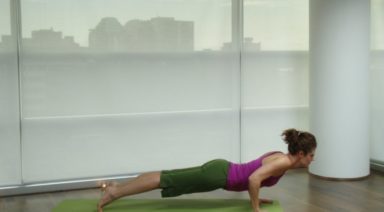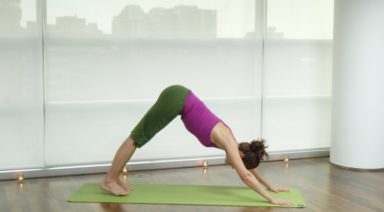Addiction Recovery Through Yoga
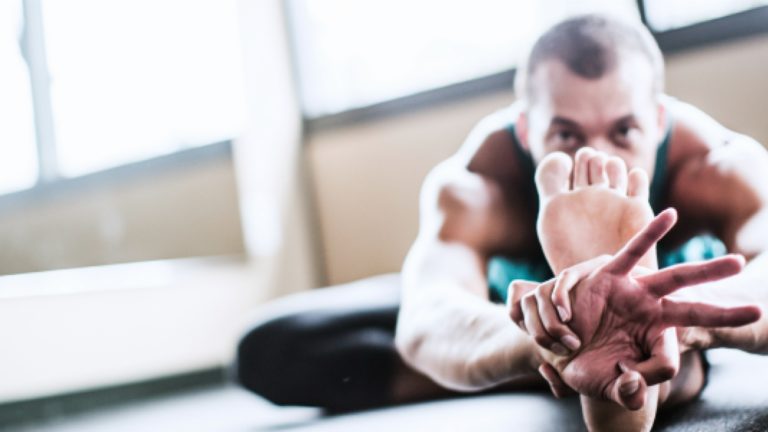
With all the images online of toned women in tights pulling themselves into pretzel-like poses, it’s easy to focus on the physical side of yoga, thinking of it as an exercise class that ends with a mini nap. But the ancient practice of yoga can also help with drug and alcohol addiction, diseases that affect millions of us in this fast-paced, modern world.
While yoga can be a powerful tool for personal transformation and recovery, many people write it off before even stepping onto a mat, saying they’re not flexible enough or they can’t afford the classes. Yet the mind-body connection, stress relief and personal growth that can occur through the regular practice of yoga can be just what a recovering addict needs. Yoga encourages a person to reconnect to their breath, body, mind and heart. Here are just a few ways yoga can help release the mind and body from the grips of drug and alcohol addiction.
Yoga Eases Stress
“It was such a crazy/stressful/hectic day… I need a drink” is such a common phrase in our culture, it’s easy to forget that there are healthy ways to cope with stress. Many addicts have become so dependent on their substance of choice, they’ve forgotten that movement or even just a few deep breaths can bring a real sense of calm to the day. And that moment of calm can lead to healthier choices as you move toward a sober life.
The benefits of mindful movement and breathing, which are at the center of many yoga classes, have been proven to increase overall health.
According to the American Institute of Stress, 20 to 30 minutes of deep breathing has been shown to help the body kick into a relaxation response, where stress levels drop and blood pressure decreases. “Deep breathing increases the supply of oxygen to your brain and stimulates the parasympathetic nervous system, which promotes a state of calmness,” according to an article on the organization’s website. “Breathing techniques help you feel connected to your body—it brings your awareness away from the worries in your head and quiets your mind.”
Nearly all yoga classes encourage students to consciously inhale and exhale, which brings peace to the mind and body, even as we move through a practice. If you commit even further, and regularly practice at home or at a studio, you might find yourself using deep breathing or a short yoga sequence to help you stay strong through a moment of temptation or stress.
This is especially important for addicts, as many suffer from post-acute withdrawal symptoms, or PAWS, in the early stages of recovery. These symptoms often include anxiety and mood swings. One study has shown that yoga directly helps to increase GABA, a neurotransmitter that aids in relaxing the nervous system, therefore improving your mood and decreasing anxiety.
Yoga Increases Self-Awareness
Addicts are often accused by their loved ones of being selfish. But devoting regular time to the kind of reflection that comes with yoga can be beneficial to those in recovery. More meditative types of the practice, like Yin Yoga, where there is little movement and just a few poses done in a single class, can create a meaningful space for really checking in with ourselves. While the questions that come to mind might not always be pleasant, these classes are set up as safe spaces for students to release emotions, and teachers are aware that their students might be struggling with all kinds of personal issues while in their studio. This type of contemplative yoga can help with anxiety, depression and even sleep issues. By dealing with some of the other factors that might be causing stress and unhappiness in your life, you might have more resolve or energy to commit to a recovery plan or time in a rehabilitation center.
Addressing the Roots of Addiction
Yoga is not superior in dealing with one addiction over another. Yoga begins to address the roots of a problem rather than the symptoms, making it a common tool among recovery from many addictions. If someone struggling with alcohol or drug addiction gets sober only to find him- or herself struggling with another addiction, such as food or gambling, yoga practices can be implemented to support in recovery from both addictions.
Yoga for General Wellbeing
Yoga can also be used as a tool to support general wellbeing regardless of addiction. For example, long deep breathing, or “yogic breathing,” has been shown to reduce levels of the stress hormone cortisol and increase stress resilience. Yoga can also be used to assist in dealing with trauma. According to Dr. Bessel van der Kolk, an expert in the field of trauma treatment, yoga may be more effective than many medications in treating PTSD. “Medication can be quite nice to sort of dampen some of the symptoms,” he states. “But in the end, people need to own their bodies, they need to own their physical experiences. And, in order to overcome your trauma, it needs to be safe to go inside and to experience yourself.”
Yoga asks you to show up for yourself. Although deep breathing can help relieve stress at any moment during the day, a physical yoga practice requires regularly carving out time for yourself. Even if you are just going to spend a few minutes stretching in your living room, you still must make the time to practice. As with any other type of physical exercise, you’ll see more benefits if you practice regularly. Yoga, for example, has been proven to ease chronic back pain and joint pain. Some studies have found that it can also help with mental health issues.
German researchers, for example, studied a small group of women who described themselves as “emotionally distressed.” Over a three-month period, they took two 90-minute yoga classes a week. At the end of the study, their stress, anxiety and overall health all improved. Similar studies have also shown the one-off benefits of even attending a single yoga class. The uniting factor in all of these cases? The participants showed up for themselves and attended a class. They might have had stressful days or felt anxiety about trying yoga or were plagued by depression, but they put all of that aside and spent the hour (or more) bending, breathing and stretching.
It’s easy to put off a yoga practice: to buy a mat or a DVD and let it go dusty. Or to attend a single class, but never step foot in the studio again. But the more you commit to yourself, and a regular mind-body practice, the more overall benefits you’ll begin to see and feel. A single healthy decision, like deciding to roll out your yoga mat, can change your focus for the day and encourage another healthy decision. Over time, those mindful moments will add up, perhaps leading to an overall more positive outlook and healthier lifestyle.
The Art of Surrender
Yoga requires us to surrender. The first of the 12 steps in Alcoholics Anonymous is “We admitted we were powerless over alcohol, that our lives had become unmanageable.” In a similar vein, yoga asks again and again that we drop everything that is not necessary in our lives. Most teachers will begin the class with a mind-clearing exercise and a short moment to set an intention. This helps us focus on the moment, and release all the other stresses in life. Similarly, some poses require surrender, as well.
Maybe there’s a complicated pose in class that you simply cannot twist your body into. That doesn’t mean you have to flop down on your mat or write the pose off for good. It simply means that accepting that today, that pose is not happening.
The same idea is true during some of the more “relaxing” poses. While your body might be still in a seated position, you may feel your mind racing. Again, yoga teaches us to simply surrender and to be present with who we are, where we are, right now. By engaging in a regular practice, we learn that acceptance comes with not being able to control the world around us but by allowing the world around us to exist as it is. By doing so we learn the art and gift of peaceful surrender.
In terms of learning to let go of expectations and limitations, yoga can be a boon for those who are recovering from addiction. In AA, the moment of surrender becomes “the firm bedrock upon which a happy and purposeful life is built.” The same is true in yoga: When we accept that a pose is out of our reach or that our minds cannot be quieted, we might finally find a moment of true freedom.
Yoga and Lymphatic Circulation

According to Live Science, “the lymphatic system is a network of tissues and organs that help rid the body of toxins, waste and other unwanted materials,” including a fluid that contains white blood cells that help fight infections. You are probably most familiar with the lymph nodes in the lymphatic system, but the lymphatic system travels through your body from your tonsils and adenoids to your spleen. There are lymph nodes located around vital organs like your heart and lungs and in your armpit and near your groin area.
This internal system produces the antibodies necessary to kill bad actors in your body and prevent an infection in one part of your body from spreading to another. If your lymphatic system stops working, fluids begin to build up in your body and several different conditions can occur, including infections, swollen glands, blockages, autoimmune disorders, certain types of cancer, and lymphedema. Since the lymphatic system travels through so many parts of your body, it is crucial that we keep it healthy.
Yoga and Lymphatic Circulation
As you may know, yoga is one of the best practices for strengthening the body and reducing stress. What you might not realize is the role yoga plays in increasing circulation throughout the body. Increasing circulation helps allow the lymphatic system to transport good stuff and filter out the bad, which means that any amount or type of yoga will improve your lymphatic system.
Think of the lymphatic system as a super highway that filters toxins and circulates antibodies throughout your body. This system is critical to getting you better when you are sick. Moreover, unlike the way blood travels through the body, the heart does not control the pumping of the lymphatic system. Instead, the system moves by muscular contractions. Even more reason to strengthen your muscles.
One aspect of yoga that has dramatic effects on the lymphatic system is pranayama. Pranayama is the practice of deep, controlled breathing. By practicing these deep breaths, you are able to better circulate good fluids throughout your body and remove bad toxins.
Routine Maintenance of the Lymphatic System
Yoga poses that invert the legs and allow gravity to act on the lymphatic channels are particularly helpful to keeping the system flowing and functioning optimally. In addition to these type of poses, any dynamic postures that build heat and keep the body moving are also beneficial. For these yoga postures to be the most productive, focus more on your breath than perfecting the postures. Below are some sample poses to get you started:
Downward Facing Dog Adho Mukha Svanasana
A classic pose, but did you know that it builds strength throughout the body and improves the functioning of your immune system? To attempt this pose, firmly plant your feet at the bottom of your mat, then place your hands at the top of your mat so that your body forms an upside V. If you are already under-the-weather when you try this, have a block nearby to rest your head.
Cat-Cow – Bitilasana
By far my favorite yoga pose, Cat-Cow gets everything flowing with only moderate effort. First, go into Tabletop pose (your hands and knees firmly planted on your mat, with your toes pointed behind you). Now arch your back like a cat, letting your gaze fall to the floor in between your outstretched hands. Next, curve your spine the other way your body forms a U the other way. Your head should face towards the ceiling. Do this at least two dozen times, then rest in Child’s Pose to finish.
Sun Salutations are a great way to build strength and increase circulation throughout the body.
Standing Forward Bend – Uttanasana
Gather two blocks before planting your feet firmly on the back of your mat. Spread your feet a little wider than hip-widths apart and then rest your head on top of the bricks. Stay here for several deep breaths.
Other Practices to Improve Lymphatic System
- Water, water and more water. Drinking plenty of fluids is far and away the best method for improving and maintaining all of the systems in your body.
- Go for a brisk walk. Keep your arms and legs moving and walk faster than normal. This will jumpstart your lymphatic system and get all the good stuff flowing.
- In addition to the restorative yoga and low-intensity positions, there are other types of yoga for when you are sick, including Yin Yoga specially tailored to the winter cold and flu season.
Poses for a Weak Lymphatic System
I’ll be honest, I am the worst when I’m sick. Rarely do I feel like anything more than sitting on the sofa and watching reruns, much less partaking in a full yoga session. But, if you are able to get yourself up and moving, there are some low-intensity postures that can help a cold run its course faster so you can get back to feeling like yourself again.
A cold or allergies means that your lymphatic system is blocked. In addition to whatever your doctor recommends, include these chest-opening yoga postures into your get-well-soon regime.
Start by dimming the lights in the room and have extra blankets and blocks nearby, as the last thing you want to do is over-exert yourself. Feel free to turn any of these poses into supported poses. These postures should be done more like restorative yoga.
Bridge Pose is a great chest opener, but if you are feeling under-the-weather try the Supported Bridge Pose – Setu Bandha Sarvangasana – it is much easier on achy joints. Lie down on your mat with your palms down. Bending your knees, pull your heels towards your fingertips. Then push down with your hands to lift your hips up, while you slide a brick lengthwise under your torso. Lastly, pull your shoulder blades in towards each other as much as possible. You should feel your chest opening. Close your eyes and relax while gravity does the work for you.
Bow Pose – Dhanurasana
Traditionally best for strengthening your abdomen, but also stimulates your thymus gland and rejuvenates the parts of the lymphatic system closest to your chest. Try this pose when you have a lot of post-nasal drip flowing into your chest. Begin face-down on your mat – extra blankets are suggested for this one. Separate your legs on the mat about hips-width. Take several deep breaths. Then, as your release your breath, grab hold of your ankles so that your body is shaped like an archer’s bow. Continue to lift your thighs off the mat until you exhale and lower yourself back down to the mat. Repeat two to three times.
Cobra Pose – Bhujangasana
Often part of Sun Salutations, Cobra Pose is another ideal chest opener. Lie face-down on your mat and take several deep breaths. Place your hands, fingers spread wide, on the mat under your shoulders. Press your body into your mat and as you inhale, begin to straighten your arms. You will rise off the mat, except your hands and the tops of your feet. Keep your body tightened. Bend your head back slightly so your gaze moves from in front of you towards the ceiling. Hold this for your full breath, then come back to your mat and exhale. Repeat for a minute.
Extended Triangle Pose – Utthita Trikonasana (as pictured above)
Spread your legs wide so you take up the entire mat lengthwise. Your left foot should be pointed towards the front of the room; your back or right foot turned perpendicular to your front foot. Keep your abdomen tucked in. Put your left hand on your left ankle and hold on. Then, twist your right arm towards the ceiling and hold for three deep breaths. Now switch arms and hold for another three breaths.
Legs Up the Wall – Viparita Karani
Last, but not least, this pose lets gravity do the work so you can relax. Move your mat up against the wall at place a blanket or two on top. Lie on top of the blankets with your bottom against the wall and your legs going up the wall. You should form an “L.” Stretch out your arms so your torso and arms form a “T.” Then, close your eyes and lie there for at least fifteen minutes. I don’t know about you, but – sick or not sick – I could do this one all day!



